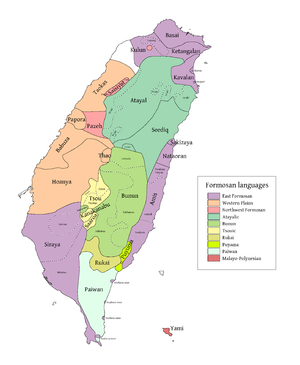邹语群
(重定向自邹语族)
邹语群(Tsouic、Cou)或称曹语群是台湾原住民使用的台湾南岛语言之一,分布在台湾中南部的南投县、嘉义县、高雄市等地山区。学者将此语群又分为北邹语群和南邹语群。北邹语群即通称为邹语(Tsou),又称“阿里山邹语”;南邹语群又分为卡那卡那富语(Kanakanavu)和拉阿鲁哇语(Hla'alua)。南邹语群的卡那卡那富语和拉阿鲁哇语音位数在台湾南岛语中是最少的,只有13个辅音和4个元音。(Blust 2009:165).[1]而这两个语言也高度濒危,因为多数语者都已转用布农语或台湾华语。
| 邹语群 | |
|---|---|
| Tsouic languages、Cou | |
| (有争议) | |
| 地理分布 | 台湾 |
| 谱系学分类 | 南岛语系
|
| 分支 | |
| – | |
 邹语群 | |
日本学者土田滋于1975年发表古邹语音韵系统的重建,这个重建获得白乐思 (Blust 1999)和李壬癸 (Li 2008)的支持。然而张永利 (Chang 2006)[2]和罗斯(Ross 2009)[3]认为邹语群并非一个有效的分群;罗斯将南邹群的两个语言置于核心南岛语 (Nuclear Austronesian) 之下,并认为(北)邹语为南岛语较早期的一个分支。
族群与争议
编辑拉阿鲁哇族于 2009年由高雄县议员谢贵来与桃源乡乡长谢垂耀发起正名运动,争取为独立族群不再托付于邹族之下。[4][5][6][7]拉阿鲁哇族与卡那卡那富族分别于2014年6月26日正式独立为族。[8]。
邹语音韵
编辑1975年土田滋在耶鲁大学完成的博士论文“古邹语音韵的构拟”(Reconstruction of Proto-Tsouic Phonology),是迄今最详尽完备的邹语群语音史的著作。[9][10]
从原始南岛语至邹语发生下列几项音变(Li 2008:215)。[11]
- *C, *d > c
- *y > 原始邹语 *z
- *R > r
注释
编辑- ^ Blust, Robert A. The Austronesian Languages. Canberra: Pacific Linguistics, Research School of Pacific and Asian Studies, Australian National University, 2009. ISBN 0-85883-602-5, ISBN 978-0-85883-602-0.
- ^ Chang, Henry Yungli. 2006. "Rethinking the Tsouic Subgroup Hypothesis: A Morphosyntactic Perspective." In Chang, H., Huang, L. M., Ho, D. (eds.). Streams converging into an ocean: Festschrift in honor of Professor Paul Jen-Kuei Li on his 70th birthday. Taipei: Institute of Linguistics, Academia Sinica.
- ^ Ross, Malcolm. 2009. "Proto Austronesian verbal morphology: A reappraisal." In Alexander Adelaar and Andrew Pawley (eds.). Austronesian historical linguistics and culture history: a festschrift for Robert Blust. Canberra: Pacific Linguistics.
- ^ 记者王纪青,"拉阿鲁哇族争取正名为第15族"[1],联合报,2009.12.17 06:46 pm.
- ^ 邱英哲,"语言流失与复振:以高中村Hla'alua人为例"存档副本. [2009-12-17]. (原始内容存档于2008-10-09).,2008/07/.
- ^ 郭基鼎,"Hla'alua人的社会生活、文化认同与族群意识:以桃源乡高中村为例 "[2][永久失效链接],2008/07/.
- ^ 记者欧阳良盈、杨孟立、胡宗凤/高雄报导,"消失的南岛语言 头目儿子都不学"存档副本. [2011-12-14]. (原始内容存档于2010-11-05).,联合报,2010.11.02 12:37 pm.
- ^ 原住民族委员会," 行政院核定拉阿鲁哇族及卡那卡那富族,原民会:加强复振族语"存档副本. [2014年7月12日]. (原始内容存档于2014年7月13日).,原住民族委员会万维网 新闻稿,2014/06/26 11:55:58.
- ^ 古鄒語音韻的構擬. [2011-08-16]. (原始内容存档于2019-06-13).
- ^ 李壬癸(Paul Jen-kuei Li),"台湾南岛语言的语音符号(Orthographic Systems for Formosan Languages)",教育部教育研究委员会(Ministry of Education ROC),台北市(Taipei),中华民国八十年五月(May 1991)
- ^ Li, Paul Jen-kuei. 2008. "Time perspective of Formosan Aborigines." In Sanchez-Mazas, Alicia ed. Past human migrations in East Asia: matching archaeology, linguistics and genetics. Taylor & Francis US.
延伸阅读
编辑- Tsuchida, S. (1976). Reconstruction of Proto-Tsouic phonology. [Tokyo: Institute for the Study of Languages and Cultures of Asia and Africa, Tokyo Gaikokugo Daigaku.
- Chang, Henry Yungli (2006). "Rethinking the Tsouic Subgroup Hypothesis: A Morphosyntactic Perspective." In Chang, H., Huang, L. M., Ho, D. (eds.). Streams converging into an ocean: Festschrift in honor of Professor Paul Jen-Kuei Li on his 70th birthday. Taipei: Institute of Linguistics, Academia Sinica.